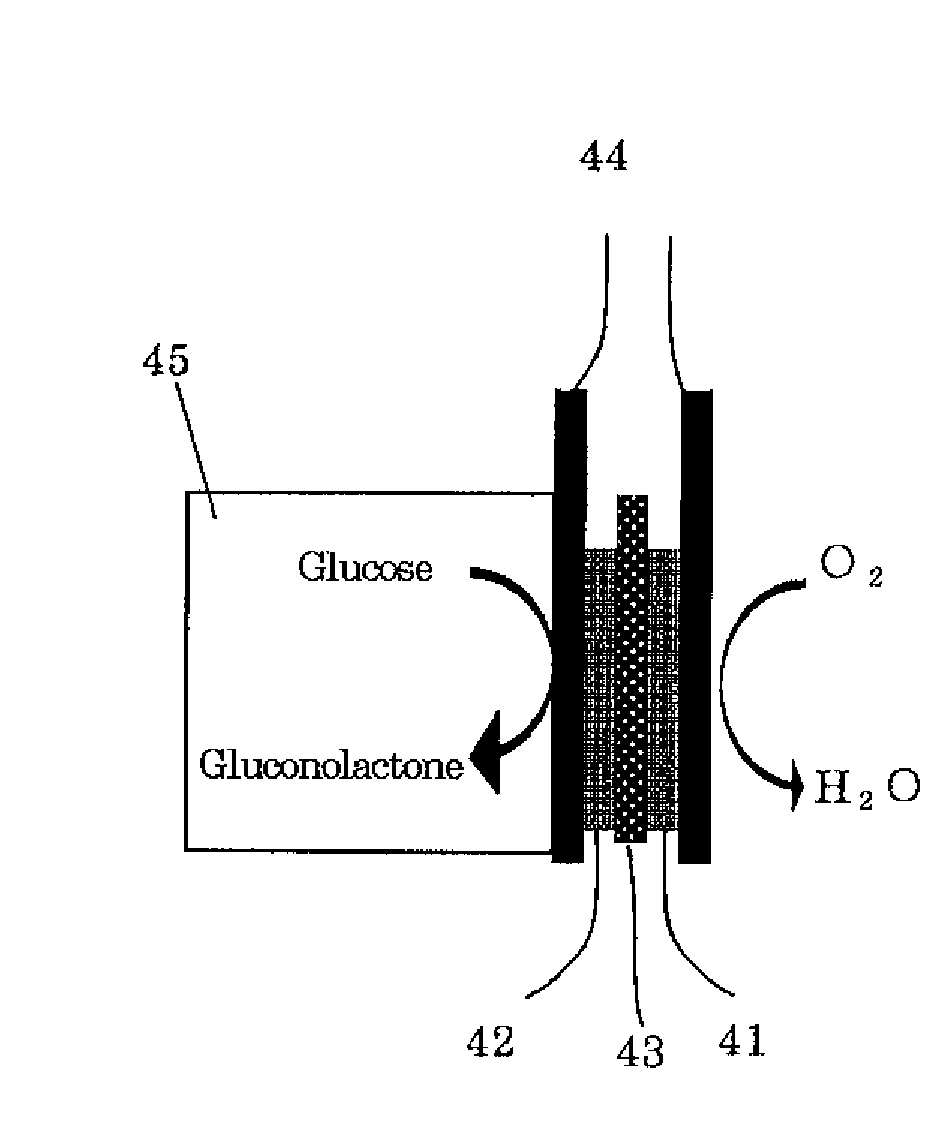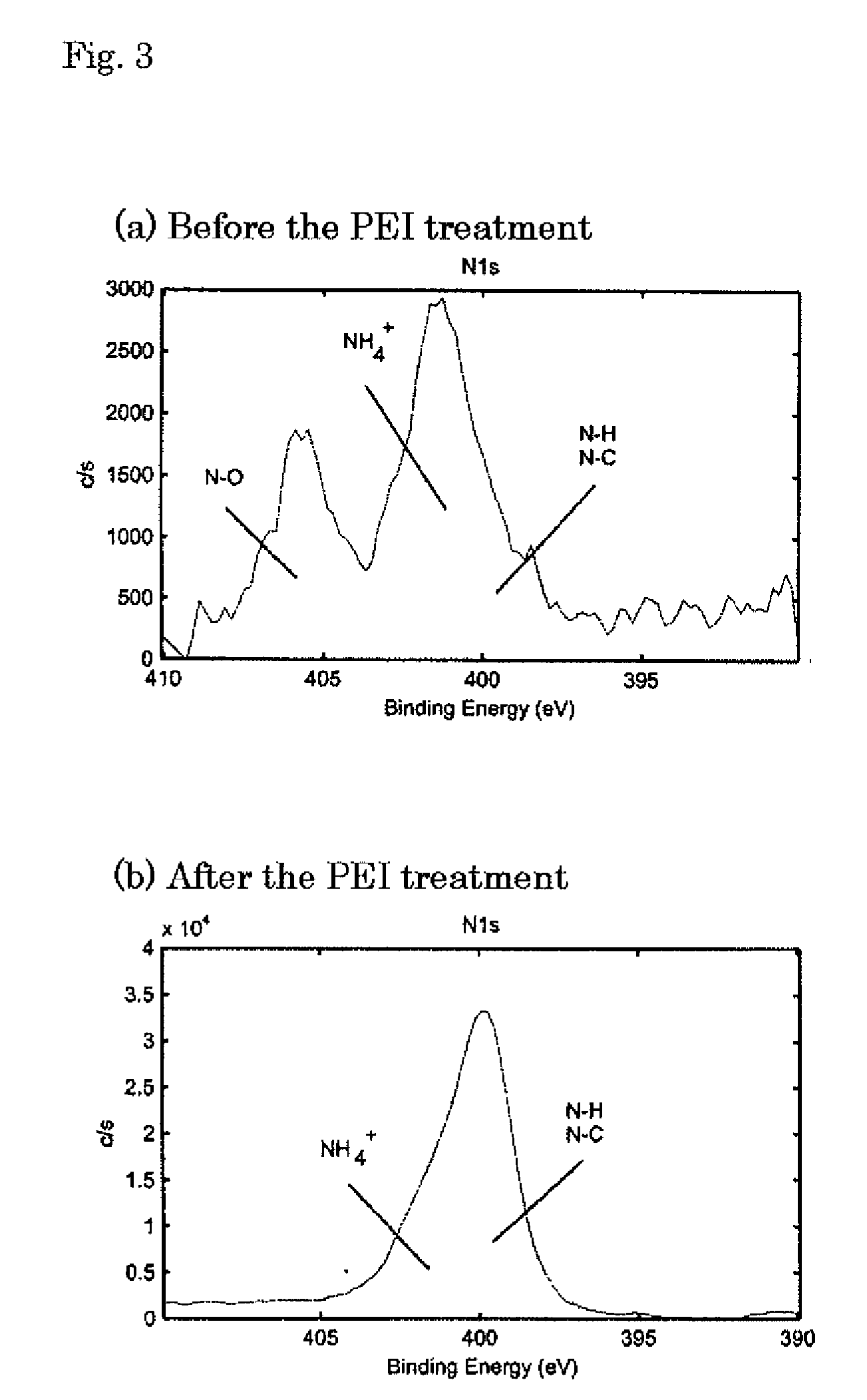Carbon membrane having biological molecule immobilized thereon
a carbon membrane and biological molecule technology, applied in the field of porous carbon membranes, can solve problems such as insufficient performance, and achieve the effects of large electric response, high biological molecule functionality, and excellent biological molecule activity
- Summary
- Abstract
- Description
- Claims
- Application Information
AI Technical Summary
Benefits of technology
Problems solved by technology
Method used
Image
Examples
referential example 1
Production of the Porous Polyimide Film
[0146]Using biphenyltetracarboxylic dianhydrides (s-BPDA) as a tetracarboxylic acid component and p-phenylenediamine (PPD) as a diamine component, the monomer components were dissolved in NMP so that their total weight was 8 wt %, and polymerization was carried out to give the solution of polyimide precursor having a logarithmic viscosity (30° C., concentration; 0.5 g / 100 mL NMP) of 3.3.
[0147]The obtained polyimide precursor solution was flowed and cast in its thickness of about 400 μm, and further to its upper part NMP was uniformly applied by using a doctor's knife and they were left at rest for one minute, followed by immersing that stacking for 8 minutes into a congelation bath in which methanol and isopropanol were well mixed in a volume ratio of 1 vs. 1 to replace the solvent, whereby causing the precipitation of the polyimide precursor and forming the porous structure. After the porous film of the precipitated polyimide precursor was imm...
referential example 2
Production of the Porous Carbon Membrane
[0148]The porous polyimide film produced by Referential Example 1 was carbonized under nitrogen gas stream at a temperature of 1600° C. to give the porous carbon film having a film thickness of about 80 μm, an air permeability of 126 sec / 100 ml, a vacancy ratio of 40%, and a mean pore diameter of 0.13 μm. The BET specific surface area by nitrogen adsorption measurement was also 13.8 m2 / g. FIG. 1 shows the surface SEM image of the obtained carbon membrane, and FIG. 2 shows its cross-section SEM image.
[0149]The membrane properties were measured in accordance with the following method.
[0150](1) Air Permeability
It was measured in accordance with JIS P8117. As a measurement instrument, B-type Gurley densometer (made by Toyo Seiki) was used. The sample membrane is tightened over a round hole with a diameter of 28.6 mm and area of 645 mm2, the air inside of the cylinder is allowed to pass through from the test-round-hole zone to outside by the weight...
example 1
Oxidation Treatment of the Porous Carbon Membrane
[0155]The porous carbon membrane 2.00 g was measured off into a 300 ml flat-bottom separable flask, and normal concentration nitric acid 100 ml was added and they were gently refluxed for 8 hours. Then, they were collected by filtration, and washing with purified water was repeated until the pH of the washing solution became neutral. Then, drying was carried out under reduced pressure. Since a method for evaluating the oxidation degree of carbon has not been generally established, the elemental analysis used for usual analyses for organic compounds was adopted. An increase in oxygen contents was observed responding to the nitric acid treatment when such analysis was applied for this sample. Therefore, this was used as one of the evaluation means of oxidation degree. Table 4 shows those results.
TABLE 4Results of the elemental analysis.Nitric acid concentrationElementuntreated69%35%20%10%HN.D.1.330.960.34N.D.C99.9870.4382.3794.9398.95NN...
PUM
| Property | Measurement | Unit |
|---|---|---|
| Specific surface area | aaaaa | aaaaa |
| Molar density | aaaaa | aaaaa |
| Molar density | aaaaa | aaaaa |
Abstract
Description
Claims
Application Information
 Login to View More
Login to View More - R&D
- Intellectual Property
- Life Sciences
- Materials
- Tech Scout
- Unparalleled Data Quality
- Higher Quality Content
- 60% Fewer Hallucinations
Browse by: Latest US Patents, China's latest patents, Technical Efficacy Thesaurus, Application Domain, Technology Topic, Popular Technical Reports.
© 2025 PatSnap. All rights reserved.Legal|Privacy policy|Modern Slavery Act Transparency Statement|Sitemap|About US| Contact US: help@patsnap.com



